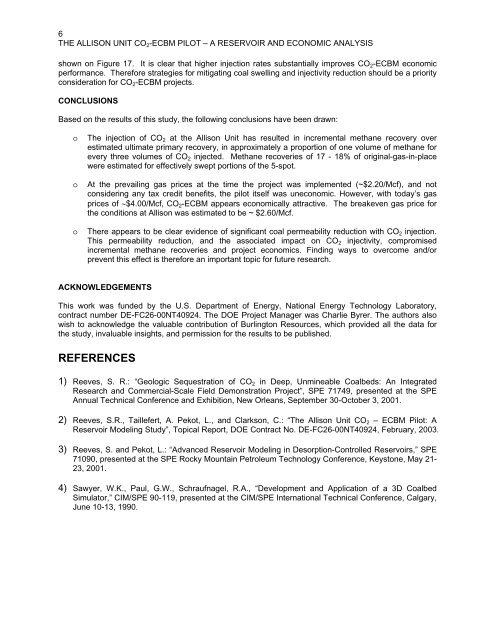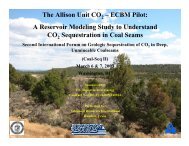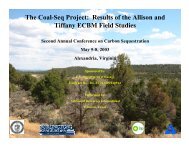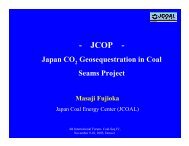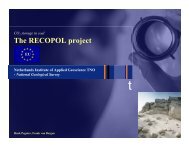The Allison Unit CO2-ECBM Pilot - A Reservoir and ... - Coal-Seq
The Allison Unit CO2-ECBM Pilot - A Reservoir and ... - Coal-Seq
The Allison Unit CO2-ECBM Pilot - A Reservoir and ... - Coal-Seq
Create successful ePaper yourself
Turn your PDF publications into a flip-book with our unique Google optimized e-Paper software.
6<br />
THE ALLISON UNIT CO 2 -<strong>ECBM</strong> PILOT – A RESERVOIR AND ECONOMIC ANALYSIS<br />
shown on Figure 17. It is clear that higher injection rates substantially improves CO 2 -<strong>ECBM</strong> economic<br />
performance. <strong>The</strong>refore strategies for mitigating coal swelling <strong>and</strong> injectivity reduction should be a priority<br />
consideration for CO 2 -<strong>ECBM</strong> projects.<br />
CONCLUSIONS<br />
Based on the results of this study, the following conclusions have been drawn:<br />
o <strong>The</strong> injection of CO 2 at the <strong>Allison</strong> <strong>Unit</strong> has resulted in incremental methane recovery over<br />
estimated ultimate primary recovery, in approximately a proportion of one volume of methane for<br />
every three volumes of CO 2 injected. Methane recoveries of 17 - 18% of original-gas-in-place<br />
were estimated for effectively swept portions of the 5-spot.<br />
o At the prevailing gas prices at the time the project was implemented (~$2.20/Mcf), <strong>and</strong> not<br />
considering any tax credit benefits, the pilot itself was uneconomic. However, with today’s gas<br />
prices of ∼$4.00/Mcf, CO 2 -<strong>ECBM</strong> appears economically attractive. <strong>The</strong> breakeven gas price for<br />
the conditions at <strong>Allison</strong> was estimated to be ~ $2.60/Mcf.<br />
o<br />
<strong>The</strong>re appears to be clear evidence of significant coal permeability reduction with CO 2 injection.<br />
This permeability reduction, <strong>and</strong> the associated impact on CO 2 injectivity, compromised<br />
incremental methane recoveries <strong>and</strong> project economics. Finding ways to overcome <strong>and</strong>/or<br />
prevent this effect is therefore an important topic for future research.<br />
ACKNOWLEDGEMENTS<br />
This work was funded by the U.S. Department of Energy, National Energy Technology Laboratory,<br />
contract number DE-FC26-00NT40924. <strong>The</strong> DOE Project Manager was Charlie Byrer. <strong>The</strong> authors also<br />
wish to acknowledge the valuable contribution of Burlington Resources, which provided all the data for<br />
the study, invaluable insights, <strong>and</strong> permission for the results to be published.<br />
REFERENCES<br />
1) Reeves, S. R.: “Geologic <strong>Seq</strong>uestration of CO 2 in Deep, Unmineable <strong>Coal</strong>beds: An Integrated<br />
Research <strong>and</strong> Commercial-Scale Field Demonstration Project”, SPE 71749, presented at the SPE<br />
Annual Technical Conference <strong>and</strong> Exhibition, New Orleans, September 30-October 3, 2001.<br />
2) Reeves, S.R., Taillefert, A. Pekot, L., <strong>and</strong> Clarkson, C.: “<strong>The</strong> <strong>Allison</strong> <strong>Unit</strong> CO 2 – <strong>ECBM</strong> <strong>Pilot</strong>: A<br />
<strong>Reservoir</strong> Modeling Study”, Topical Report, DOE Contract No. DE-FC26-00NT40924, February, 2003.<br />
3) Reeves, S. <strong>and</strong> Pekot, L.: “Advanced <strong>Reservoir</strong> Modeling in Desorption-Controlled <strong>Reservoir</strong>s,” SPE<br />
71090, presented at the SPE Rocky Mountain Petroleum Technology Conference, Keystone, May 21-<br />
23, 2001.<br />
4) Sawyer, W.K., Paul, G.W., Schraufnagel, R.A., “Development <strong>and</strong> Application of a 3D <strong>Coal</strong>bed<br />
Simulator,” CIM/SPE 90-119, presented at the CIM/SPE International Technical Conference, Calgary,<br />
June 10-13, 1990.


